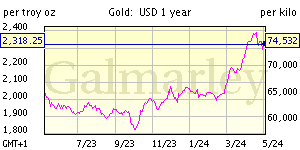Followers
Tuesday, December 7, 2010
Salam Maal Hijrah
Assalamualaikum warahmatullahi wabarakatuh ,,
Selamat Tahun Baru 1432 Hijrah diucapkan kepada encik Belog dan juga kepada semua pengunjung Belog ini !
Pelaburan emas dan perak memang menguntungkan. Tetapi jangan dilupakan pelaburan pahala untuk bekalan di Akhirat kelak. Emas dan perak bertimbun-timbun pun tak guna kalau amal kebajikan dan tanggungjawab kepada Allah S.W.T. diabaikan.
Firman Allah dalam Surah At-Taubah :
Wahai orang-orang yang beriman! Sesungguhnya banyak di antara pendita-pendita dan ahli-ahli ugama (Yahudi dan Nasrani) memakan harta orang ramai dengan cara yang salah, dan mereka menghalangi (manusia) dari jalan Allah (Islam). Dan (ingatlah) orang-orang yang menyimpan emas dan perak serta tidak membelanjakannya pada jalan Allah, maka khabarkanlah kepada mereka dengan (balasan) azab seksa yang tidak terperi sakitnya.
(Iaitu) pada hari dibakar emas perak (dan harta benda) itu dalam neraka jahanam, lalu diselar dengannya dahi mereka, dan rusuk mereka, serta belakang mereka (sambil dikatakan kepada mereka): “Inilah apa yang telah kamu simpan untuk diri kamu sendiri, oleh itu rasalah (azab dari) apa yang kamu simpan itu.
[At-Taubah: ayat 34 - 35]
Diharap tahun baru ini akan lebih baik dari tahun sebelumnya. Marilah sama-sama muhasabah diri dan berubah ke arah kebaikan. InshaAllah. Semoga berada dalam rahmat Allah selalu.
Assalamualaikum . . .
Monday, December 6, 2010
Gold Chart - 1 year Gold (2010)
The price of all US Dollar denominated commodities, like gold, will change to reflect the fact that it will take fewer or more dollars to buy that commodity. So it’s quite possible, in fact it’s almost always the case that a portion of the change in the price of gold is really just a reflection of a change in the value of the US Dollar. Sometimes that portion is insignificant. But often the opposite is true where the entire change in the gold price is simply a mathematical recalculation of an ever-changing US Dollar value.
When the dollar gets strong, gold appears to go down, and vice versa. That accounts for part of the fluctuations that we see in the value of gold.
The other part is an actual increase in the supply or demand for gold. If the price is higher when being measured not only in US Dollars, but also in Euros, Pounds Sterling, Japanese Yen, and every other major currency, then we know the gold demand is higher and it has actually increased in value.
Consequently, if gold is higher in US Dollars while at the same time cheaper in every other currency, then we can conclude that the US Dollar has weakened, and that gold has actually lost value in all other currencies. But the price, because it is being quoted in $USD will be higher and give the illusion of gold becoming more valuable. In such a case the devaluation of gold, due to increased supply on the market, is camouflaged by a weakened US Dollar.
Source : www.kitco.com
Friday, December 3, 2010
Thursday, December 2, 2010
The Theft of Nations – Returning to Gold
The Story of the Sukus and the Tukus

One day, two smartly dressed men arrived in a ship on the shores of the island of Aya . Their names were Gago and Sago. The Sukus being a very hospitable people welcomed their new guests. Gago and Sago impressed the Sukus with the stories of their extensive traveling. They showed them some gold coins from other parts of the world and also some printed papers that were apparently used by some far-away people as money.

Gago and Sago convinced the people that an institution called a bank would benefit the people immensely. They explained that a bank would provide a place for keeping their gold money safe while uplifting their economic conditions by making the savings available to others for productive use, which otherwise would remain idle. The Sukus, being a people who loved to help others, thought that was a great idea. Gago and Sago then built a small building structure with a vault in it and started operating the first bank on the island of Aya .
They celebrated the occasion by giving the islanders a great feast along with a colourful festival of events. The people thronged to deposit their gold coins with the bank. Depositors were given a piece of printed paper for every gold coin they deposited, with the assurance that they could redeem a gold coin for every paper they turned in. The people were excited with the paper “money” they got because it even had a picture of their leader Saka beside a banana tree. No doubt Saka was very pleased too!
The people deposited all their gold coins, a total of 100,000 pieces and hence an equivalent number of pieces of paper were given out. Now the people used the paper as money and found that it was much more convenient than the heavier gold coins that they used before. The paper money printed by Gago and Sago, therefore, became the dominant currency of the island. Nobody used the fold coins anymore. The people were pleased with the ease with which they were able go about doing their businesses. They trusted Gago and Sago very much because each time they brought in a piece of paper for redemption their request was indeed honoured. Gago and Sago became very respected and honoured in their society.
The Tukus who heard about the whole thing became excited and pleaded with Gago and Sago to help them out too. Gago and Sago smile to each other and told the Tukus that they would indeed be very pleased to do so. They then set up a similar building in Baya, and Sago was placed there as the manager. The difference between Aya and Baya was that in Baya the Tukus had no gold coins to deposit. Sago told them that was alright. He would however, give 1,000 paper notes to each family to use as money. Since they were a hundred families in Baya, so 100,000 paper notes were given out. However, Sago reminded them that at the end of the year each family must return 1,100 paper notes, the 10 per cent extra being a charge for the services he was providing. The Tukus found the paper money truly to be like magic. It made their business dealings so much easier compared to their previous barter trade. People spent much less time looking for counter parties to trade with. Now they were able to specialize in jobs they were good at. Their economy began to grow rapidly. Now Gago and Sago decided that the time was ripe for them to do their “trick”.
Gago noticed that in Aya, on average only 10 per cent of the fold deposits were redeemed by the Sukus at any particular time. The other 90 per cent remained in the vaults. Noticing that their printed papers were circulating as money, Gago printed an extra 900,000 certificates to be circulated as money too! Gago had calculated that with the extra papers, a total of 1,000,000 pieces of paper would be outstanding and if the people came to redeem their normal 10 per cent, then the 100,000 original deposit of gold coins would be readily available for redemption.3 Gago loaned out this extra 900,000 paper money to some “needy” Sukus at an interest charge of 15 per cent.
The Sukus suddenly found that the prices of things were rising. This baffled them and no one could figure out why.4 Some of them who had borrowed money form Gago were not able to pay back their debt even though they worked very hard trying to earn that extra money.5 Business became increasingly competitive and the society became less compassionate and less caring towards others than previously.6
The Tukus too found similar things happening to them. Initially, they did not notice any price increase but they noticed some behavioural change in their people. They became very competitive in their attitude and less caring towards their fellows. Even with hard work and such competitive behaviour, some of the Tukus still defaulted on their loans. They were not able to acquire enough money to pay back their total debt.7
Now Sago began to confiscate real wealth from the loan defaulters –like land, cows, sheep, etc. Their elderly leader Taka was among those who defaulted. But Sago gave him and some other Tukus additional paper notes as a rescheduling of their loans. This increased further their indebtedness. Later Taka defaulted again and had his loan rescheduled again. Now Taka began to avoid meetings with Sago. He felt ashamed and found his former power, pride, courage and dignity falling.8
On the contrary, he found that Sago was slowly becoming very wealthy by acquiring the people’s assets. In fact, he found that the power, pride, courage and dignity that he lost were now enthroned on Sago.
After a number of years, Gago and Sago who once arrived on the shores of the island of Aya with only a printing machine, were now the owners of most of the land and property in both Aya and Baya. The people were reduced to mere workers, some of them now living in poverty. Many worked long hours just to make ends meet. They now had less time for family, friends or for religious activities. Social problems were widespread.
People cared less for other. It goes without saying that with poverty, other social ills like crime, prostitution, etc. began to thrive. Their cultures were gradually replaced because Gago and Sago introduce a new “superior” culture of a “superior” people to which they belonged. This was the end of the caring and loving people of the two islands Aya and Baya, who had earlier lived a peaceful yet graceful life before Gago and Sago arrived with a printing machine.
Gago and Sago did not stop there. They continued to spread their wings to other peoples and societies. Their ultimate dream is to become the Global Supreme Rulers by establishing a single global bank with single global money.
We postulate here that in the current global monetary system, developing nations would go through somewhat similar events as pictured above.
___________________________________
3 This is how money is created in the current banking system in aggregate. If the reserve requirements is 10 per cent, then for a deposit of 100,000 a total loan that can be created is given by 100,000/0.10 = 1,000,000
4 This is easy to see with the help of the equation of exchange, MV = PY. In this example, with the sudden increase in the money supply M, without a corresponding increase in real output of goods and services Y, the prices levels, i.e. P thus tend to increase ( the velocity of circulation, V, is assumed unchanged and constant).
5 The loan (principle plus interest) is not repayable in aggregate because the interest portion does not exist in the form of money. Notice that the interest of 15% on the 900,000 principal equals 135,000. Therefore the total amount repayable is 1,035,000 but nonetheless, only 1,000,000 exist in total as money in the whole system. Accordingly, some defaults on the loans are sure to take place.
6 Since interest charge do not exist in the form of money, competition for money therefore ensues, reflected in increase business competition.
7 Again, this is because there is not enough money in the system as a whole such that debt is not repayable in aggregate.
8 Imagine that you borrowed RM10,000 from a friend. Do you think your behaviour toward the friend would change, say when you meet the friend in the street? Particularly when the stipulated time for the return of the loan had expired?
,
,
,
Credit To Prof Ahamed Kameel Mydin Meera for his book The Theft of Nations – Returning to Gold
Subscribe to:
Comments (Atom)











